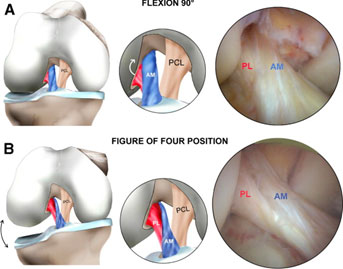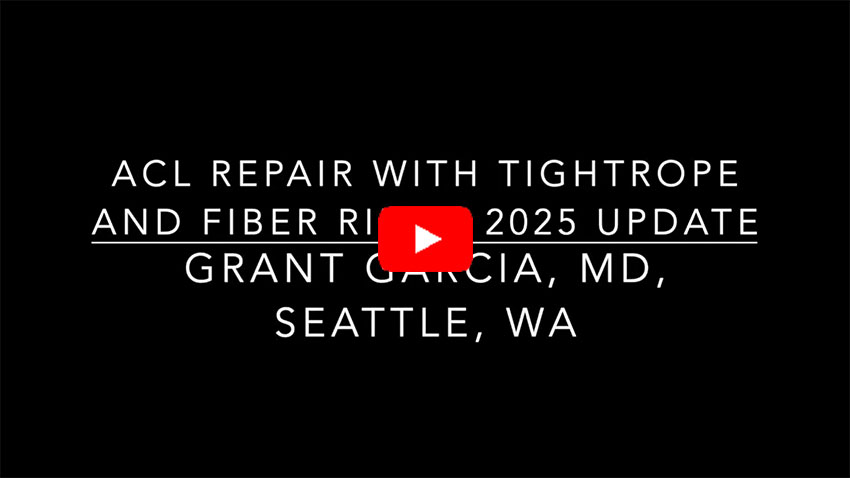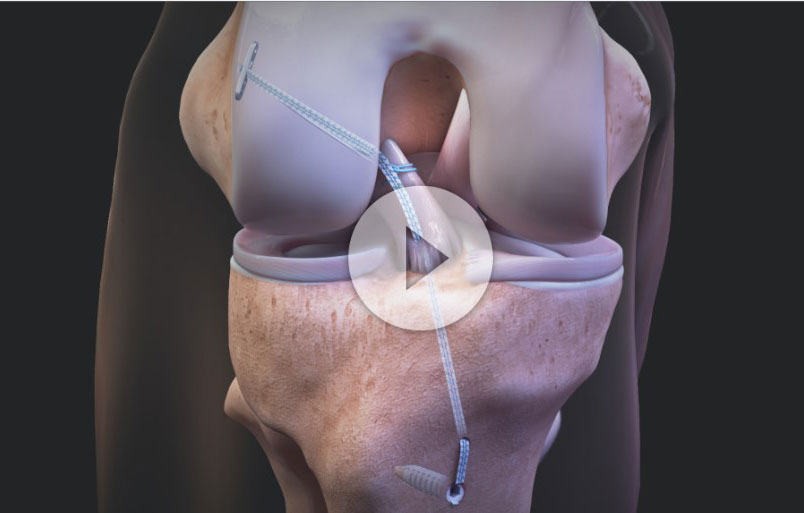ACL Preservation (ACL Repair) Surgery
ACL Repair 2025 Update
-
ACL Repair Introduction
-
ACL Repair Surgery and Outcomes

Introduction:
ACL tears are an extremely common injury, which can require extensive downtime and physical therapy. The most common treatment for ACL tears has been reconstruction. More recent data has demonstrated certain ACL tear patterns are amenable to repair and preservation. In these select cases there is a major advantage to repair, including less pain, quicker recovery and faster return to sport.
Check out this video testimonial after using the new Arthrex ACL repair technique to preserve the patient’s original ACL
Background:
The anterior cruciate ligament, or ACL, is one of the major ligaments of the knee that is in the middle of the knee and runs from the femur (thigh bone) to the tibia (shin bone). It prevents the tibia from sliding out in front of the femur. Together with posterior cruciate ligament (PCL) it provides rotational stability to the knee. An ACL injury is a sports related injury that occur when the knee is forcefully twisted or hyperextended. An ACL tear usually occurs with an abrupt directional change with the foot fixed on the ground or when the deceleration force crosses the knee. Changing direction rapidly, stopping suddenly, slowing down while running, landing from a jump incorrectly, and direct contact or collision, such as a football tackle can also cause injury to the ACL. When you injure your ACL, you might hear a "popping" sound and you may feel as though the knee has given out. Within the first two hours after injury, your knee will swell and you may have a buckling sensation in the knee during twisting movements.
What are the most recent innovations at this year’s national orthopedics meeting: ACL repair, 3D printing, tendon transfers. Dr. Garcia discusses it all.
Symptoms
When you injure your ACL, you might hear a loud "pop" sound and you may feel the knee buckle. Within a few hours after an ACL injury, your knee may swell due to bleeding from vessels within the torn ligament. You may notice that the knee feels unstable or seems to give way, especially when trying to change direction on the knee.
Diagnosis
BEAR implant and ACL restorations
An ACL injury can be diagnosed with a thorough physical examination of the knee and diagnostic tests such as X-rays, MRI scans and arthroscopy. X-rays may be needed to rule out any fractures. In addition, your doctor will often perform the Lachman’s test to see if the ACL is intact. During a Lachman test, knees with a torn ACL may show increased forward movement of the tibia and a soft or mushy endpoint compared to a healthy knee. Pivot shift test is another test to assess ACL tear. During the pivot shift test, if the ACL is torn the tibia will move forward when the knee is completely straight and as the knee bends past 30° the tibia shifts back into correct place in relation to the femur.
Check out our new ACL Repair (Preservation) technique to help patients get back from ACL injury faster with better outcomes.
Candidates:
Certain patients with ACL tears are good candidates for this type of surgery. Patients need to be older than 25 years and have a special type of injury pattern. The most common indication is when the ACL ruptures directly off the femur (proximal tear) and is still good quality. If a patient meets these criteria, they are potentially a good candidate for repair. Even if patients meet these criteria, they need to weight the risks and benefits having an ACL repair compared to a standard reconstruction. Dr. Garcia will discuss these extensively during each patient’s consultation.
Testimonial after innovative repair of her ACL ligament tear.
Surgery:
The older ACL repair/preservation techniques involved outdated methods with higher failure rates and overall poor outcomes. Much the hesitancy around repairing an injured ACL comes from these previous techniques and data. More recent innovative surgical methods have shown impressive results with high satisfaction rates (>90 percent) and return to sport (>90 percent). Dr. Garcia is one of the few surgeons in Washington state that performs this surgery. His goal is preservation when possible and by preserving the ACL, this can lead to faster recovery and maintenance of the ACL’s proprioceptive properties.
The surgery is performed with 4 small poke holes in which a high tensile suture is weaved into the ACL. Then, using an innovative fixation device, it is cinched tightly against the wall of the femur where the torn ACL can grow back into its anatomic footprint. This repair is then augmented with an internal brace to the tibia, which has been show in a number of studies to add further biomechanical strength to the repair. This combination of internal bracing, with biologic augmentation and newer ACL repair techniques is one of the most impressive advances in the last few years.
Results:
Dr. Garcia’s 2023 technique for ACL repair with internal brace
More recent data using appropriate selection of patients, has shown re-tear risk of ACL repairs around 5-7%, compared re-tear risks of ACL reconstruction around 3-4%. While this may not be for everyone, there are a number of factors patients must consider before deciding. Firstly, the recovery after ACL repair is significantly faster with return to full sports around 4 months compared to 7-9 months after ACL reconstruction. In addition, if failure occurs after ACL repair, the revision procedure is much easier and has lower risks compared to a failed ACL reconstruction. For many patients this trade-off is worth the risk, but the decision-making process is always up to the patient. Dr. Garcia offers numerous ACL treatment options to make a custom treatment approach for each patient and athlete.
Physical Therapy:
Physical therapy is performed after surgery usually starting within the first week postoperatively. Patients usually return to full sports in 4 months. Please see Dr. Garcia’s physical therapy section for more information on this rehab protocol.
Biologic ACL Repair with Dr. Garcia
2nd look after ACL Repair
Staged ACL Repair with MACI, TTO and MPFL reconstruction
ACL Repair Testimonial 2025





















